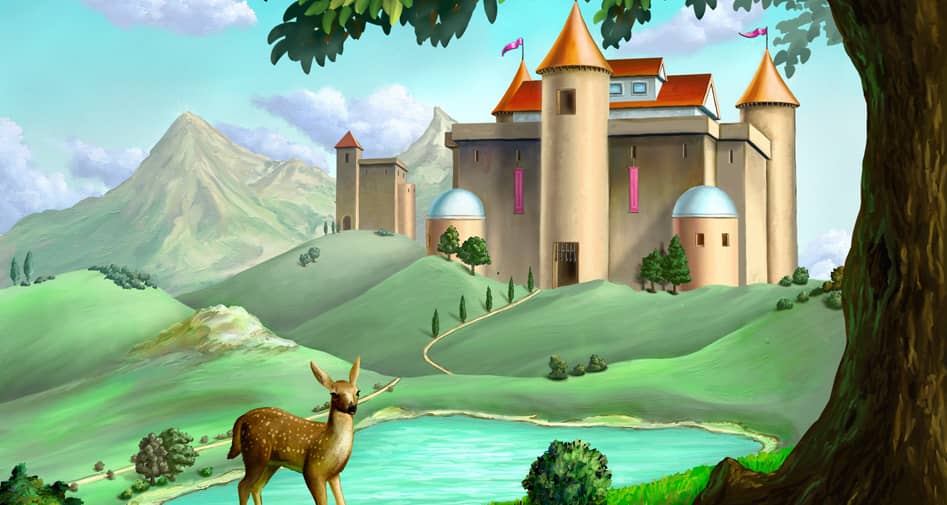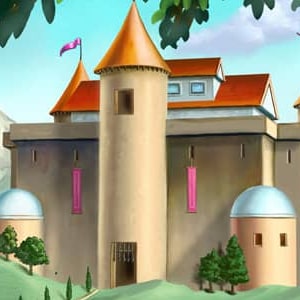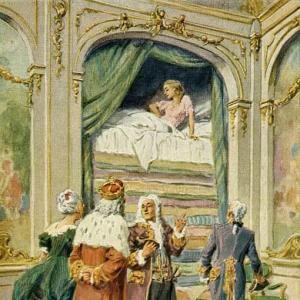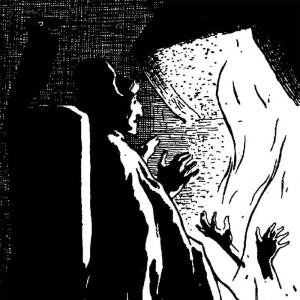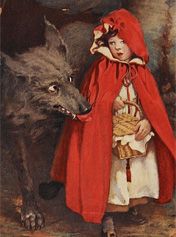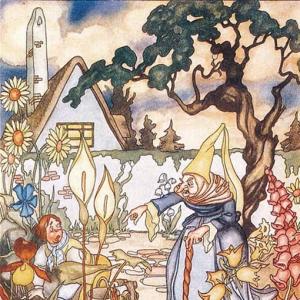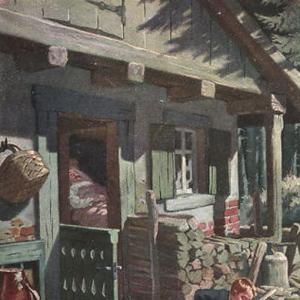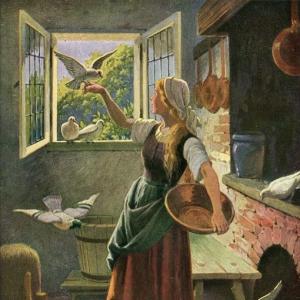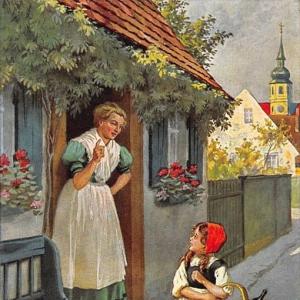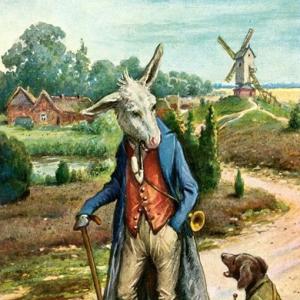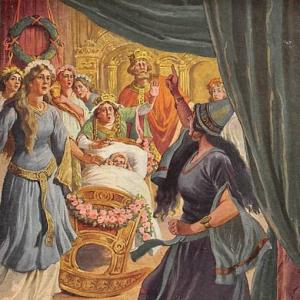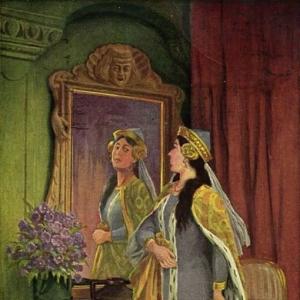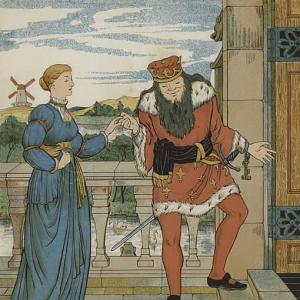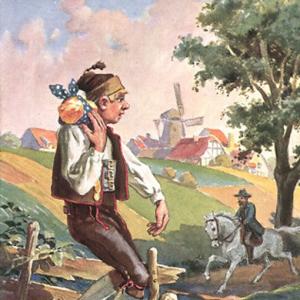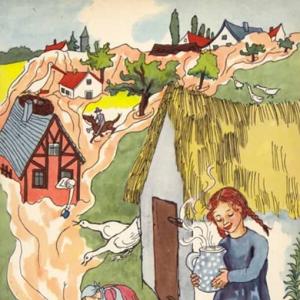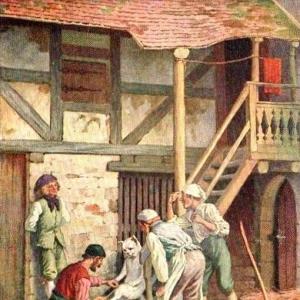Reading time for children: 7 min
There were once two brothers, the one rich, the other poor. The rich one, however, gave nothing to the poor one, and he gained a scanty living by trading in corn, and often did so badly that he had no bread for his wife and children. Once when he was wheeling a barrow through the forest he saw, on one side of him, a great, bare, naked-looking mountain, and as he had never seen it before, he stood still and stared at it with amazement. While he was thus standing he saw a twelve great, wild men coming towards him, and as he believed they were robbers he pushed his barrow into the thicket, climbed up a tree, and waited to see what would happen. The twelve men, however, went to the mountain and cried, „Semsi mountain, Semsi mountain, open,“ and immediately the barren mountain opened down the middle, and the twelve went into it, and as soon as they were within, it shut. After a short time, however, it opened again, and the men came forth carrying heavy sacks on their shoulders, and when they were all once more in the daylight they said, „Semsi mountain, Semsi mountain, shut thyself;“ then the mountain closed together, and there was no longer any entrance to be seen to it, and the twelve went away.
When they were quite out of sight the poor man got down from the tree, and was curious to know what really was secretly hidden in the mountain. So he went up to it and said, „Semsi mountain, Semsi mountain, open,“ and the mountain opened to him also. The he went inside, and the whole mountain was a cavern full of silver and gold, and behind lay great piles of pearls and sparkling jewels, heaped up like corn. The poor man hardly knew what to do, and whether he might take any of these treasures for himself or not; but at last he filled his pockets with gold, but he left the pearls and precious stones where they were. When he came out again he also said, „Semsi mountain, Semsi mountain, shut thyself;“ and the mountain closed itself, and he went home with his barrow.
And now he had no more cause for anxiety, but could buy bread for his wife and children with his gold, and wine into the bargain. He lived joyously and uprightly, gave help to the poor, and did good to every one. When, however, the money came to an end he went to his brother, borrowed a measure that held a bushel, and brought himself some more, but did not touch any of the most valuable things. When for the third time he wanted to fetch something, he again borrowed the measure of his brother. The rich man had, however, long been envious of his brother’s possessions, and of the handsome way of living which he had set on foot, and could not understand from whence the riches came, and what his brother wanted with the measure. Then he thought of a cunning trick, and covered the bottom of the measure with pitch, and when he got the measure back a piece of money was sticking in it. He at once went to his brother and asked him, „What hast thou been measuring in the bushel measure?“ – „Corn and barley,“ said the other. Then he showed him the piece of money, and threatened that if he did not tell the truth he would accuse him before a court of justice. The poor man then told him everything, just as it happened. The rich man, however, ordered his carriage to be made ready, and drove away, resolved to use the opportunity better than his brother had done, and to bring back with him quite different treasures.
When he came to the mountain he cried, „Semsi mountain, Semsi mountain, open.“ The mountain opened, and he went inside it. There lay the treasures all before him, and for a long time he did not know which to clutch at first. At length he loaded himself with as many precious stones as he could carry. He wished to carry his burden outside, but, as his heart and soul were entirely full of the treasures, he had forgotten the name of the mountain, and cried, „Simeli mountain, Simeli mountain, open.“ That, however, was not the right name, and the mountain never stirred, but remained shut. Then he was alarmed, but the longer he thought about it the more his thoughts confused themselves, and his treasures were no more of any use to him. In the evening the mountain opened, and the twelve robbers came in, and when they saw him they laughed, and cried out, „Bird, have we caught thee at last! Didst thou think we had never noticed that thou hadst been in here twice? We could not catch thee then. This third time thou shalt not get out again!“ Then he cried, „It was not I, it was my brother,“ but let him beg for his life and say what he would, they cut his head off.
 Learn languages. Double-Tap on one word.Learn languages in context with Childstories.org and Deepl.com.
Learn languages. Double-Tap on one word.Learn languages in context with Childstories.org and Deepl.com.Backgrounds to fairy tale „Simeli mountain“
„Simeli Mountain,“ also known as „Simeliberg“ or „The Glass Mountain,“ is a lesser-known fairy tale from the Brothers Grimm collection, „Grimms‘ Fairy Tales.“ As with many other tales in the collection, the story is rooted in German and European folklore and oral traditions.
The backgrounds of „Simeli Mountain“ can be traced to several cultural, literary, and historical influences:
Folklore and oral traditions: The Brothers Grimm collected their stories from various sources, including friends, family members, and local storytellers. „Simeli Mountain“ is no exception, as it comes from the rich tradition of German and European folktales and oral narratives.
Magic and enchantment: „Simeli Mountain“ belongs to the tradition of fairy tales that involve magical or enchanted objects, places, and events. The tale features a magical mountain that only opens when the protagonist says the correct words, echoing the themes of secret knowledge and the power of language found in many other fairy tales.
Riddles and wordplay: The story features a series of riddles that the protagonist must solve to gain access to the mountain and its treasures. Riddles and wordplay are common elements in many folktales and fairy tales, often serving as a test of the protagonist’s wit and resourcefulness.
Morality and virtue: The tale can be seen as a morality tale, teaching the importance of honesty, loyalty, and keeping one’s promises. The protagonist’s adherence to his promise to share his newfound wealth with his brother plays a central role in the story, reflecting the values of the time.
Literary influences: As with many of their tales, the Brothers Grimm were influenced by the works of other writers and collectors of folktales, such as Charles Perrault and Hans Christian Andersen. These authors included stories with similar themes and motifs, providing inspiration for the Grimms to incorporate these elements in their own collection.
In summary, „Simeli Mountain“ is a fairy tale that combines elements from folklore, oral traditions, magical enchantments, riddles, and morality tales. The story reflects the rich tapestry of influences and themes found in the Brothers Grimm’s broader collection of fairy tales.
Interpretations to fairy tale „Simeli mountain“
„Simeli Mountain“ offers a variety of interpretations that touch upon human values, the power of language, and moral lessons. Here are some possible ways to understand the story:
The power of language and knowledge: One of the central themes in „Simeli Mountain“ is the power of language and secret knowledge. The protagonist gains access to the mountain and its treasures only by knowing and uttering the correct words. This theme underscores the importance of knowledge and the power that language can hold in unlocking mysteries and opportunities.
Morality and virtue: The story can be seen as a morality tale that teaches the importance of honesty, loyalty, and keeping one’s promises. The protagonist is rewarded for his adherence to his promise to share his newfound wealth with his brother. This interpretation emphasizes the importance of maintaining moral values and staying true to one’s word.
The consequences of greed: In the tale, the protagonist’s brother becomes greedy and tries to access the mountain’s treasures on his own, without knowing the secret words. As a result, he becomes trapped inside the mountain, illustrating the consequences of greed and the dangers of trying to take shortcuts in the pursuit of wealth and success.
The importance of resourcefulness and wit: The story features a series of riddles and challenges that the protagonist must overcome to access the mountain’s treasures. This aspect of the tale highlights the value of resourcefulness, problem-solving, and wit in navigating difficult situations and achieving success.
The transformative power of experience: At the beginning of the story, the protagonist is a poor man who relies on his brother for support. Through his encounters with the enchanted mountain, he becomes wealthy and self-sufficient, demonstrating the transformative power of experience and personal growth.
In conclusion, „Simeli Mountain“ offers multiple interpretations that encourage readers to reflect on themes such as the power of language, moral values, the consequences of greed, resourcefulness, and the transformative power of experience.
Adaptions of the fairy tale „Simeli mountain“
„Simeli Mountain“ is a lesser-known Brothers Grimm fairy tale and, as a result, it has not been adapted as extensively as some of the more popular tales in the collection. Nevertheless, there have been some adaptations and retellings of the story across different forms of media:
Literature: „Simeli Mountain“ has been included in various collections of Grimm fairy tales and occasionally retold in children’s books, often with illustrations accompanying the text. One example is the retelling by author and illustrator Eric Kimmel in „The Glass Mountain: Tales from Poland,“ where the story is adapted and merged with elements of Polish folklore.
Theater: While standalone plays or musicals specifically dedicated to „Simeli Mountain“ are relatively rare, the story has been incorporated into broader theatrical adaptations of Grimm fairy tales, such as ensemble performances or storytelling events where actors and storytellers bring multiple tales to life on stage.
Animation and Film: Adaptations of „Simeli Mountain“ in film or animation are scarce, primarily due to the story’s lesser-known status. However, independent filmmakers and animators might find inspiration in the tale and create short films or animations that incorporate elements of the story or reinterpret it in new and imaginative ways.
Art and Illustration: Artists and illustrators have created visual representations of „Simeli Mountain“ in various forms, such as paintings, drawings, and illustrations for books or other publications. These visual depictions often emphasize the magical and mysterious aspects of the story, such as the enchanted mountain and the treasures it contains.
Though „Simeli Mountain“ has not been adapted as widely as some of the more famous Grimm fairy tales, its rich narrative and intriguing themes still offer opportunities for creative reinterpretation and adaptation in various forms of media.
Adaptions of the fairy tale „Simeli mountain“
While „Simeli Mountain“ is not one of the more popular fairy tales from Brothers Grimm, there have been a few adaptations and retellings of the story over the years. Here are some examples:
„The Mountain Princess“ by Loretta Ellen Brady – This is a children’s book adaptation of the story with colorful illustrations.
„Simeliberg“ by William J. Brooke – This is a retelling of the story in verse form, first published in 1926.
„The Talking Fox“ by Niki Daly – This is a South African adaptation of the story, in which a young boy named Sibusiso goes on a quest to find the Talking Fox and save his village from drought.
„Simeliberg: A Fantasy Novella“ by E. C. Hibbs – This is a modern retelling of the story with a darker, more complex plot.
„The Simeli Mountain“ by Blanca Álvarez – This is a Spanish-language retelling of the story with colorful illustrations.
These adaptations vary in terms of tone, style, and target audience, but all draw on the basic elements of the original tale, such as the quest for a mysterious mountain, the talking fox, and the theme of personal growth and self-discovery.
Summary of the plot
„Simeli Mountain,“ also known as „Simeliberg“ or „The Glass Mountain,“ is a lesser-known Brothers Grimm fairy tale. The story follows two brothers, one wealthy and the other poor. The poor brother, unable to make a living, relies on the support of his wealthy sibling. One day, the poor brother decides to venture into the forest to gather wood to sell. While in the forest, he encounters a mysterious little man who informs him about a nearby mountain filled with treasures, which will open when the correct words are spoken.
The poor brother follows the little man’s instructions, recites the magic words, and gains access to the mountain. Inside, he discovers an abundance of silver, gold, and precious stones. As promised, he shares his newfound wealth with his wealthy brother. However, the wealthy brother becomes greedy and desires to acquire more treasure for himself.
The wealthy brother visits the mountain but does not know the magic words to enter and exit safely. Consequently, he becomes trapped inside the mountain, leaving the poor brother to inherit his estate.
The tale of „Simeli Mountain“ is a story of moral values, loyalty, and the consequences of greed. It also emphasizes the power of language, the importance of resourcefulness, and the transformative power of experience.
————–
Backgrounds to fairy tale „Simeli mountain“
„Simeli Mountain“ is a German fairy tale collected by the Brothers Grimm, Jacob and Wilhelm, who were famous for their collection of folktales and legends. The story was published in the first edition of their collection, titled „Kinder- und Hausmärchen“ (Children’s and Household Tales), which was released in 1812. The Brothers Grimm were not only known for their work as collectors and editors of folktales but also for their significant contributions to linguistics, philology, and German cultural history.
The Grimm brothers were born in the late 18th century in Hanau, Germany. They were both scholars who shared a deep interest in the preservation of folklore and the study of the German language. Their primary goal was to collect and document the oral traditions of their culture, which they believed were disappearing due to the process of industrialization and urbanization.
The tales compiled by the Brothers Grimm have become an essential part of Western literary and cultural history, influencing countless authors, artists, and filmmakers. Their collection of fairy tales includes widely known stories such as „Cinderella,“ „Hansel and Gretel,“ „Rapunzel,“ and „Snow White.“ These stories often feature moral lessons and cautionary themes, which have resonated with audiences across generations.
„Simeli Mountain“ is one of the lesser-known stories in the Grimm brothers‘ collection but shares common themes with their other tales, such as the importance of generosity, the dangers of greed and envy, and the idea of justice and retribution.
Interpretations to fairy tale „Simeli mountain“
„Simeli Mountain“ is a fairy tale that contains several themes and moral lessons that can be interpreted in various ways:
The consequences of greed and envy: The rich brother’s envy of his sibling’s newfound wealth leads him down a path of deceit and ultimately to his tragic end. His greed prevents him from remembering the name of the mountain, which results in his capture and death. This tale serves as a warning against allowing greed and envy to consume one’s life.
The power of generosity and compassion: The poor brother, despite his initial struggles, chooses to be generous and compassionate with his newfound wealth. He helps the less fortunate and does good deeds, ultimately leading a fulfilling and happy life. This theme emphasizes the importance of kindness and selflessness, which can lead to a more meaningful existence.
The danger of secrets and dishonesty: The poor brother’s secret about the mountain leads to his sibling’s discovery and eventual demise. This theme highlights the potential harm that can come from keeping secrets and being dishonest with others, even when intentions might be good.
The significance of humility and contentment: The poor brother is content with the gold he takes from the mountain, leaving the more valuable treasures behind. This demonstrates the importance of being humble and appreciating what one has, rather than always striving for more.
The idea of justice and retribution: The rich brother’s actions ultimately lead to his punishment at the hands of the robbers. This theme suggests that those who act unjustly and selfishly may eventually face the consequences of their actions.
Overall, „Simeli Mountain“ offers a moral lesson on the importance of generosity, compassion, humility, and contentment, while cautioning against the dangers of greed, envy, dishonesty, and a lack of appreciation for what one has.
Summary of the plot
„Simeli Mountain“ is a fairy tale by the Brothers Grimm about two brothers – one rich and the other poor. The rich brother is ungenerous, while the poor brother struggles to provide for his family. One day, the poor brother stumbles upon a mysterious mountain, where he witnesses twelve wild men entering the mountain using the phrase „Semsi mountain, Semsi mountain, open.“ Intrigued, he tries the same phrase, and the mountain opens, revealing a cavern filled with silver, gold, pearls, and precious stones.
The poor brother takes some gold, leaving the other treasures untouched, and returns home to support his family. He lives joyously and generously, helping the poor and doing good deeds. When his money runs out, he returns to the mountain twice more, each time borrowing a measure from his rich brother.
However, the rich brother becomes envious of the poor brother’s newfound wealth and suspects something unusual. He devises a trick by covering the bottom of the measure with pitch, and when the poor brother returns it, a piece of money sticks to it. Confronted and threatened with legal action, the poor brother confesses everything.
Driven by greed, the rich brother visits the mountain, intending to take more valuable treasures than his sibling. He gathers as many precious stones as he can carry, but in his excitement, he forgets the name of the mountain, mistakenly calling it „Simeli mountain“ instead of „Semsi mountain.“ The mountain remains closed, trapping the rich brother inside.
In the evening, the mountain opens for the twelve wild men, who are revealed to be robbers. They recognize the rich brother from his previous visits and, despite his pleas for mercy, they execute him for his greed and deceit.
Informations for scientific analysis
Fairy tale statistics | Value |
|---|---|
| Number | KHM 142 |
| Aarne-Thompson-Uther-Index | ATU Typ 676 |
| Translations | DE, EN, DA, ES, PT, IT, JA, NL, PL, RU, TR, VI |
| Readability Index by Björnsson | 39.6 |
| Flesch-Reading-Ease Index | 71.5 |
| Flesch–Kincaid Grade-Level | 9.5 |
| Gunning Fog Index | 11.6 |
| Coleman–Liau Index | 8.8 |
| SMOG Index | 9.1 |
| Automated Readability Index | 10.8 |
| Character Count | 4.591 |
| Letter Count | 3.562 |
| Sentence Count | 34 |
| Word Count | 853 |
| Average Words per Sentence | 25,09 |
| Words with more than 6 letters | 124 |
| Percentage of long words | 14.5% |
| Number of Syllables | 1.108 |
| Average Syllables per Word | 1,30 |
| Words with three Syllables | 35 |
| Percentage Words with three Syllables | 4.1% |
